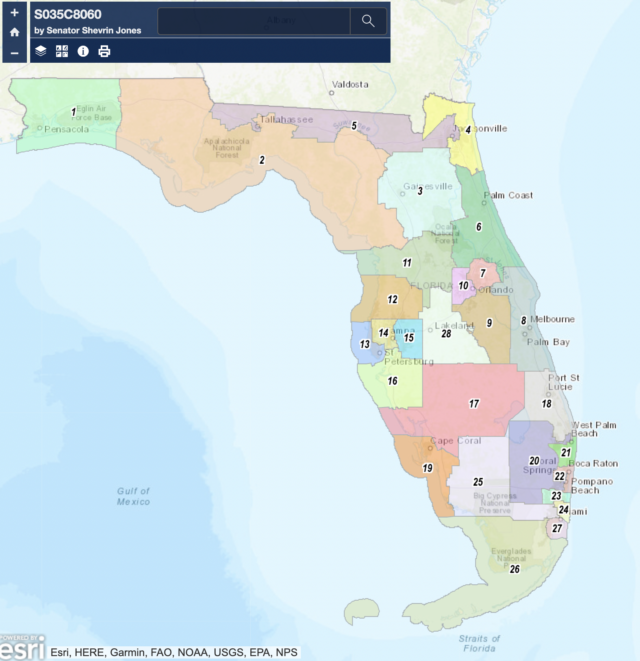
The Senate debated a draft map dividing Florida into 28 congressional districts Wednesday. The cartography became the first to reach the floor in the Legislature during the once-a-decade redistricting process.
Notably, senators on the floor approved an amendment submitted by Democratic Sen. Shevrin Jones. They proposed changing the lines of Florida’s 24th Congressional District in order to include all of Miami Gardens.
“This seeks to do one thing, keep the principal city in my district, the largest Black municipality within the state of Florida, whole within one congressional district,” Jones said.
Sen. Ray Rodrigues, an Estero Republican chairing the Senate Reapportionment Committee, considered the amendment a friendly one and an improvement on the draft advanced by the panel.
The proposed map (now S 8060) fits an extra district awarded to Florida after the 2020 Census into the high-growth I-4 corridor. The proposed Florida’s 28th Congressional District includes Lakeland, and appears most analogous to Florida’s existing 15th Congressional District. U.S. Rep. Scott Franklin, a Lakeland Republican, lives in the new CD 28, and voters in the district favored Republican Donald Trump in the 2020 presidential election.
Arguably, the true new district sits in the proposed CD 15, which becomes an east Hillsborough County jurisdiction and where voters favored Democrat Joe Biden for President.
A partisan performance analysis by MCI Maps shows the map divides Florida into 16 Trump districts and 12 Biden districts. Florida’s existing 27-member U.S. House delegation includes 16 Republicans and 11 Democrats.
The draft map potentially allows for a Democratic gain, though most political forecasters feel that’s unlikely in 2022, which is shaping up to be a GOP election cycle.
While the Senate seems to have settled on this map, it’s not the only voice weighing in. The Florida House will also draft a map before the chambers come together and decide on a final map. The House to date has produced just two proposed congressional maps, both of which lean more Republican than the Senate map.
Moreover, Gov. Ron DeSantis took the unprecedented step, at least in modern times, of having his office prepare a draft congressional map itself. Officials under DeSantis have called into question the legality of the Senate map as drafted.
That said, Florida’s Fair Districts constitutional amendment forbids lawmakers from crafting maps that favor or disfavor particular political parties or candidates. The Florida Supreme Court tossed out a map produced by the Legislature in 2012 because it said undue partisan influence helped shape the cartography.
Rodrigues stressed he doesn’t want to start negotiating with the Governor’s Office through the media. But asked about an assertion the configuration of Florida’s 5th Congressional District was an “unconstitutional gerrymander,” as asserted by DeSantis press secretary Christina Pushaw, Rodrigues expressed confidence in the Senate’s draft map.
“We were operating under the parameters that the courts offered in the lawsuits that occurred after the last round of reapportionment,” Rodrigues said. “It is clear from those lawsuits that our responsibility in creating these maps is to ensure there’s no retrogression. We are 100% confident that there is no retrogression with that map that we have passed off the floor today. And we’re prepared to defend that map in court if necessary.”
He said the Senate has operated under the premise any map ordered in place by the Florida Supreme Court in 2015 was “in and of itself constitutional.”
Rodrigues has focused over the last few months on evading any legal pitfalls that would let this map fall into the same traps. Many of the questions presented on the floor related to how closely legal guidelines were followed.
Many centered on whether the growth in Florida’s Hispanic population justified the creation of another minority district.
“Was there any analysis done to determine if the growth was located in a specific area of the state to justify the creation of a new Hispanic opportunity?” asked Sen. Victor Torres, an Orlando Democrat.
Rodrigues said much of the Hispanic growth occurred in the Central Florida area, which does get a new seat, and the Hispanic growth converted what was once an opportunity district, one where Hispanic voters conceivably could elect a U.S. Representative, to a majority-minority district.
That’s clearly a reference to Florida’s 9th Congressional District, which is represented now by U.S. Rep. Darren Soto, a Kissimmee Democrat of Puerto Rican descent.
Sen. Janet Cruz, a Tampa Democrat, also raised concerns from Tampa Bay that a traditional Hillsborough County district now crosses into Pinellas County.
“Can you tell me why are Hillsborough and Pinellas counties in one district? I live there and I think of them as separate communities,” she said.
Rodrigues said the high growth forced more compact districts and that resulted in the shifting of boundaries.
“What I would submit is I would be willing to wager that all of the counties in this state believe they’re separate communities,” he said. “The simple truth is, we had to cross boundaries in counties to draw these districts. This was just one of the boundaries that had to be crossed.”




